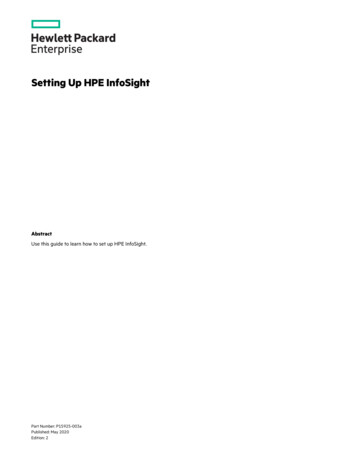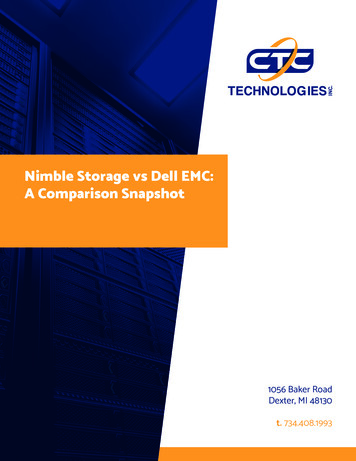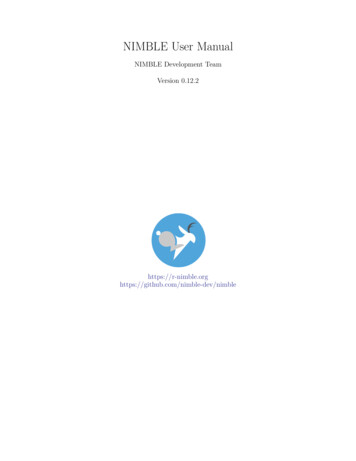
Transcription
NIMBLE User ManualNIMBLE Development TeamVersion e-dev/nimble
2
ContentsIIntroduction91 Welcome to NIMBLE111.1 What does NIMBLE do? . . . . . . . . . . . . . . . . . . . . . . . . . . . . . . . . . . 111.2 How to use this manual . . . . . . . . . . . . . . . . . . . . . . . . . . . . . . . . . . 122 Lightning introduction2.1 A brief example . . . . . . . . . . . . . . . . . . . . . . . . . . .2.2 Creating a model . . . . . . . . . . . . . . . . . . . . . . . . . .2.3 Compiling the model . . . . . . . . . . . . . . . . . . . . . . . .2.4 One-line invocation of MCMC . . . . . . . . . . . . . . . . . . .2.5 Creating, compiling and running a basic MCMC configuration .2.6 Customizing the MCMC . . . . . . . . . . . . . . . . . . . . . .2.7 Running MCEM . . . . . . . . . . . . . . . . . . . . . . . . . .2.8 Creating your own functions . . . . . . . . . . . . . . . . . . . .1313131717192022233 More introduction273.1 NIMBLE adopts and extends the BUGS language for specifying models . . . . . . . 273.2 nimbleFunctions for writing algorithms . . . . . . . . . . . . . . . . . . . . . . . . . . 283.3 The NIMBLE algorithm library . . . . . . . . . . . . . . . . . . . . . . . . . . . . . . 294 Installing NIMBLE4.1 Requirements to run NIMBLE . . . . . . . . . . . . . . . . . . .4.2 Installing a C compiler for NIMBLE to use . . . . . . . . . .4.2.1 MacOS . . . . . . . . . . . . . . . . . . . . . . . . . . . .4.2.2 Linux . . . . . . . . . . . . . . . . . . . . . . . . . . . . .4.2.3 Windows . . . . . . . . . . . . . . . . . . . . . . . . . . .4.3 Installing the NIMBLE package . . . . . . . . . . . . . . . . . . .4.4 Troubleshooting installation problems . . . . . . . . . . . . . . .4.5 Customizing your installation . . . . . . . . . . . . . . . . . . . .4.5.1 Using your own copy of Eigen . . . . . . . . . . . . . . . .4.5.2 Using libnimble . . . . . . . . . . . . . . . . . . . . . . . .4.5.3 BLAS and LAPACK . . . . . . . . . . . . . . . . . . . . .4.5.4 Customizing compilation of the NIMBLE-generated C 3.31313131323232323333343434
4IICONTENTSModels in NIMBLE375 Writing models in NIMBLE’s dialect of BUGS5.1 Comparison to BUGS dialects supported by WinBUGS, OpenBUGS and JAGS5.1.1 Supported features of BUGS and JAGS . . . . . . . . . . . . . . . . . .5.1.2 NIMBLE’s Extensions to BUGS and JAGS . . . . . . . . . . . . . . . .5.1.3 Not-yet-supported features of BUGS and JAGS . . . . . . . . . . . . . .5.2 Writing models . . . . . . . . . . . . . . . . . . . . . . . . . . . . . . . . . . . .5.2.1 Declaring stochastic and deterministic nodes . . . . . . . . . . . . . . .5.2.2 More kinds of BUGS declarations . . . . . . . . . . . . . . . . . . . . . .5.2.3 Vectorized versus scalar declarations . . . . . . . . . . . . . . . . . . . .5.2.4 Available distributions . . . . . . . . . . . . . . . . . . . . . . . . . . . .5.2.5 Available BUGS language functions . . . . . . . . . . . . . . . . . . . . .5.2.6 Available link functions . . . . . . . . . . . . . . . . . . . . . . . . . . .5.2.7 Truncation, censoring, and constraints . . . . . . . . . . . . . . . . . . .6 Building and using models6.1 Creating model objects . . . . . . . . . . . . . . . . . . . . . . . . . .6.1.1 Using nimbleModel to create a model . . . . . . . . . . . . . .6.1.2 Creating a model from standard BUGS and JAGS input files6.1.3 Making multiple instances from the same model definition . .6.2 NIMBLE models are objects you can query and manipulate . . . . .6.2.1 What are variables and nodes? . . . . . . . . . . . . . . . . .6.2.2 Determining the nodes and variables in a model . . . . . . .6.2.3 Accessing nodes . . . . . . . . . . . . . . . . . . . . . . . . . .6.2.4 How nodes are named . . . . . . . . . . . . . . . . . . . . . .6.2.5 Why use node names? . . . . . . . . . . . . . . . . . . . . . .6.2.6 Checking if a node holds data . . . . . . . . . . . . . . . . . .6.3 Using models in parallel . . . . . . . . . . . . . . . . . . . . . . . . 65666666Algorithms in NIMBLE7 MCMC7.1 One-line invocation of MCMC: nimbleMCMC . . . . . . . . . . . . . .7.2 The MCMC configuration . . . . . . . . . . . . . . . . . . . . . . . . .7.2.1 Default MCMC configuration . . . . . . . . . . . . . . . . . . .7.2.2 Customizing the MCMC configuration . . . . . . . . . . . . . .7.3 Building and compiling the MCMC . . . . . . . . . . . . . . . . . . . .7.4 User-friendly execution of MCMC algorithms: runMCMC . . . . . . .7.5 Running the MCMC . . . . . . . . . . . . . . . . . . . . . . . . . . . .7.5.1 Rerunning versus restarting an MCMC . . . . . . . . . . . . .7.5.2 Measuring sampler computation times: getTimes . . . . . . . .7.5.3 Assessing the adaption process of RW and RW block samplers7.6 Extracting MCMC samples . . . . . . . . . . . . . . . . . . . . . . . .7.7 Calculating WAIC . . . . . . . . . . . . . . . . . . . . . . . . . . . . .7.8 k-fold cross-validation . . . . . . . . . . . . . . . . . . . . . . . . . . .7.9 Variable selection using Reversible Jump MCMC . . . . . . . . . . . .67.697071717378798080818182828484
CONTENTS5.8587888889919193948 Sequential Monte Carlo, Particle MCMC, Iterated Filtering, and MCEM8.1 Particle filters / sequential Monte Carlo and iterated filtering . . . . . . . . . .8.1.1 Filtering algorithms . . . . . . . . . . . . . . . . . . . . . . . . . . . . .8.1.2 Particle MCMC (PMCMC) . . . . . . . . . . . . . . . . . . . . . . . . .8.2 Monte Carlo Expectation Maximization (MCEM) . . . . . . . . . . . . . . . . .8.2.1 Estimating the asymptotic covariance From MCEM . . . . . . . . . . .9595951001021049 Spatial models9.1 Intrinsic Gaussian CAR model: dcar normal9.1.1 Specification and density . . . . . . .9.1.2 Example . . . . . . . . . . . . . . . . .9.2 Proper Gaussian CAR model: dcar proper .9.2.1 Specification and density . . . . . . .9.2.2 Example . . . . . . . . . . . . . . . . .9.3 MCMC Sampling of CAR models . . . . . . .9.3.1 Initial values . . . . . . . . . . . . . .9.3.2 Zero-neighbor regions . . . . . . . . .9.3.3 Zero-mean constraint . . . . . . . . . .10510510510710810810911111111111210 Bayesian nonparametric models10.1 Bayesian nonparametric mixture models10.2 Chinese Restaurant Process model . . .10.2.1 Specification and density . . . .10.2.2 Example . . . . . . . . . . . . . .10.2.3 Extensions . . . . . . . . . . . .10.3 Stick-breaking model . . . . . . . . . . .10.3.1 Specification and function . . . .10.3.2 Example . . . . . . . . . . . . . .10.4 MCMC sampling of BNP models . . . .10.4.1 Sampling CRP models . . . . . .10.4.2 Sampling stick-breaking models .13IV7.9.1 Using indicator variables . . . . . . . . . . . . . . . . . . . . . .7.9.2 Without indicator variables . . . . . . . . . . . . . . . . . . . .Samplers provided with NIMBLE . . . . . . . . . . . . . . . . . . . . .7.10.1 Conjugate (‘Gibbs’) samplers . . . . . . . . . . . . . . . . . . .7.10.2 Customized log-likelihood evaluations: RW llFunction sampler7.10.3 Particle MCMC sampler . . . . . . . . . . . . . . . . . . . . . .Detailed MCMC example: litters . . . . . . . . . . . . . . . . . . . . .Comparing different MCMCs with MCMCsuite and compareMCMCs .Running MCMC chains in parallel . . . . . . . . . . . . . . . . . . . .Programming with NIMBLEOverview.12312511 Writing simple nimbleFunctions12711.1 Introduction to simple nimbleFunctions . . . . . . . . . . . . . . . . . . . . . . . . . 127
6CONTENTS11.2 R functions (or variants) implemented in NIMBLE . . . . . . .11.2.1 Finding help for NIMBLE’s versions of R functions . . .11.2.2 Basic operations . . . . . . . . . . . . . . . . . . . . . .11.2.3 Math and linear algebra . . . . . . . . . . . . . . . . . .11.2.4 Distribution functions . . . . . . . . . . . . . . . . . . .11.2.5 Flow control: if-then-else, for, while, and stop . . . . . .11.2.6 print and cat . . . . . . . . . . . . . . . . . . . . . . . .11.2.7 Checking for user interrupts: checkInterrupt . . . . . . .11.2.8 Optimization: optim and nimOptim . . . . . . . . . . .11.2.9 ‘nim’ synonyms for some functions . . . . . . . . . . . .11.3 How NIMBLE handles types of variables . . . . . . . . . . . . .11.3.1 nimbleList data structures . . . . . . . . . . . . . . . . .11.3.2 How numeric types work . . . . . . . . . . . . . . . . . .11.4 Declaring argument and return types . . . . . . . . . . . . . . .11.5 Compiled nimbleFunctions pass arguments by reference . . . .11.6 Calling external compiled code . . . . . . . . . . . . . . . . . .11.7 Calling uncompiled R functions from compiled nimbleFunctions.12 Creating user-defined BUGS distributions and functions12.1 User-defined functions . . . . . . . . . . . . . . . . . . . . . . . . . . . . . . . . . .12.2 User-defined distributions . . . . . . . . . . . . . . . . . . . . . . . . . . . . . . . .12.2.1 Using registerDistributions for alternative parameterizations and providingother information . . . . . . . . . . . . . . . . . . . . . . . . . . . . . . . . .141. 141. 142. 14513 Working with NIMBLE models13.1 The variables and nodes in a NIMBLE model . . . . . . . .13.1.1 Determining the nodes in a model . . . . . . . . . .13.1.2 Understanding lifted nodes . . . . . . . . . . . . . .13.1.3 Determining dependencies in a model . . . . . . . .13.2 Accessing information about nodes and variables . . . . . .13.2.1 Getting distributional information about a node . .13.2.2 Getting information about a distribution . . . . . .13.2.3 Getting distribution parameter values for a node . .13.2.4 Getting distribution bounds for a node . . . . . . . .13.3 Carrying out model calculations . . . . . . . . . . . . . . . .13.3.1 Core model operations: calculation and simulation .13.3.2 Pre-defined nimbleFunctions for operating on modelNodes, and getLogProbNodes . . . . . . . . . . . . . .13.3.3 Accessing log probabilities via logProb variables . . . . . . . . . . . . . . . . . . . . . . . . . . . . . . . . . . . .nodes:. . . . . . . . . . . . . . . . . . . . . . . . . . . . . . . . . . . . . . . . . . . . . . . . . . . . . . . . . . . . . . . . . . . . . . . . . . . . . . . . . . . . . . . . . . . . . . . . . . . . . . . . . .simNodes, calc. . . . . . . . . . . . . . . . . . .14 Data structures in NIMBLE14.1 The modelValues data structure . . . . . . . .14.1.1 Creating modelValues objects . . . . . .14.1.2 Accessing contents of modelValues . . .14.2 The nimbleList data structure . . . . . . . . . .14.2.1 Using eigen and svd in nimbleFunctions.15 Writing nimbleFunctions to interact with 6159159159161165167171
CONTENTS15.1 Overview . . . . . . . . . . . . . . . . . . . . . . . . . . . . . . . . . . . . . .15.2 Using and compiling nimbleFunctions . . . . . . . . . . . . . . . . . . . . . .15.3 Writing setup code . . . . . . . . . . . . . . . . . . . . . . . . . . . . . . . . .15.3.1 Useful tools for setup functions . . . . . . . . . . . . . . . . . . . . . .15.3.2 Accessing and modifying numeric values from setup . . . . . . . . . .15.3.3 Determining numeric types in nimbleFunctions . . . . . . . . . . . . .15.3.4 Control of setup outputs . . . . . . . . . . . . . . . . . . . . . . . . . .15.4 Writing run code . . . . . . . . . . . . . . . . . . . . . . . . . . . . . . . . . .15.4.1 Driving models: calculate, calculateDiff, simulate, getLogProb . . . . .15.4.2 Getting and setting variable and node values . . . . . . . . . . . . . .15.4.3 Getting parameter values and node bounds . . . . . . . . . . . . . . .15.4.4 Using modelValues objects . . . . . . . . . . . . . . . . . . . . . . . .15.4.5 Using model variables and modelValues in expressions . . . . . . . . .15.4.6 Including other methods in a nimbleFunction . . . . . . . . . . . . . .15.4.7 Using other nimbleFunctions . . . . . . . . . . . . . . . . . . . . . . .15.4.8 Virtual nimbleFunctions and nimbleFunctionLists . . . . . . . . . . . .15.4.9 Character objects . . . . . . . . . . . . . . . . . . . . . . . . . . . . . .15.4.10 User-defined data structures . . . . . . . . . . . . . . . . . . . . . . . .15.5 Example: writing user-defined samplers to extend NIMBLE’s MCMC engine15.6 Copying nimbleFunctions (and NIMBLE models) . . . . . . . . . . . . . . . .15.7 Debugging nimbleFunctions . . . . . . . . . . . . . . . . . . . . . . . . . . . .15.8 Timing nimbleFunctions with run.time . . . . . . . . . . . . . . . . . . . . . .15.9 Clearing and unloading compiled objects . . . . . . . . . . . . . . . . . . . . .15.10Reducing memory usage . . . . . . . . . . . . . . . . . . . . . . . . . . . . . 3185186187189190190190191
8CONTENTS
Part IIntroduction9
Chapter 1Welcome to NIMBLENIMBLE is a system for building and sharing analysis methods for statistical models from R, especially for hierarchical models and computationally-intensive methods. While NIMBLE is embeddedin R, it goes beyond R by supporting separate programming of models and algorithms along withcompilation for fast execution.As of version 0.12.2, NIMBLE has been around for a while and is reasonably stable, but we havea lot of plans to expand and improve it. The algorithm library provides MCMC with a lot ofuser control and ability to write new samplers easily. Other algorithms include particle filtering(sequential Monte Carlo) and Monte Carlo Expectation Maximization (MCEM).But NIMBLE is about much more than providing an algorithm library. It provides a language forwriting model-generic algorithms. We hope you will program in NIMBLE and make an R packageproviding your method. Of course, NIMBLE is open source, so we also hope you’ll contribute toits development.Please join the mailing lists (see R-nimble.org/more/issues-and-groups) and help improve NIMBLEby telling us what you want to do with it, what you like, and what could be better. We have alot of ideas for how to improve it, but we want your help and ideas too. You can also follow andcontribute to developer discussions on our GitHub repository.If you use NIMBLE in your work, please cite us, as this helps justify past and future funding forthe development of NIMBLE. For more information, please call citation('nimble') in R.1.1What does NIMBLE do?NIMBLE makes it easier to program statistical algorithms that will run efficiently and work onmany different models from R.You can think of NIMBLE as comprising four pieces:1. A system for writing statistical models flexibly, which is an extension of the BUGS language1 .2. A library of algorithms such as MCMC.3. A language, called NIMBLE, embedded within and similar in style to R, for writing algorithmsthat operate on models written in BUGS.1See Chapter 5 for information about NIMBLE’s version of BUGS.11
12CHAPTER 1. WELCOME TO NIMBLE4. A compiler that generates C for your models and algorithms, compiles that C , andlets you use it seamlessly from R without knowing anything about C .NIMBLE stands for Numerical Inference for statistical Models for Bayesian and Likelihood Estimation.Although NIMBLE was motivated by algorithms for hierarchical statistical models, it’s useful forother goals too. You could use it for simpler models. And since NIMBLE can automaticallycompile R-like functions into C that use the Eigen library for fast linear algebra, you can use itto program fast numerical functions without any model involved2 .One of the beauties of R is that many of the high-level analysis functions are themselves written inR, so it is easy to see their code and modify them. The same is true for NIMBLE: the algorithmsare themselves written in the NIMBLE language.1.2How to use this manualWe suggest everyone start with the Lightning Introduction in Chapter 2.Then, if you want to jump into using NIMBLE’s algorithms without learning about NIMBLE’sprogramming system, go to Part II to learn how to build your model and Part III to learn how toapply NIMBLE’s built-in algorithms to your model.If you want to learn about NIMBLE programming (nimbleFunctions), go to Part IV. This teacheshow to program user-defined function or distributions to use in BUGS code, compile your R codefor faster operations, and write algorithms with NIMBLE. These algorithms could be specific algorithms for your particular model (such as a user-defined MCMC sampler for a parameter in yourmodel) or general algorithms you can distribute to others. In fact the algorithms provided as partof NIMBLE and described in Part III are written as nimbleFunctions.2The packages Rcpp and RcppEigen provide different ways of connecting C , the Eigen library and R. In thosepackages you program directly in C , while in NIMBLE you program in R in a nimbleFunction and the NIMBLEcompiler turns it into C .
Chapter 2Lightning introduction2.1A brief exampleHere we’ll give a simple example of building a model and running some algorithms on the model,as well as creating our own user-specified algorithm. The goal is to give you a sense for what onecan do in the system. Later sections will provide more detail.We’ll use the pump model example from BUGS1 . We could load the model from the standard BUGSexample file formats (Section 6.1.2), but instead we’ll show how to enter it directly in R.In this ‘lightning introduction’ we will:1.2.3.4.5.6.Create the model for the pump example.Compile the model.Create a basic MCMC configuration for the pump model.Compile and run the MCMCCustomize the MCMC configuration and compile and run that.Create, compile and run a Monte Carlo Expectation Maximization (MCEM) algorithm, whichillustrates some of the flexibility NIMBLE provides to combine R and NIMBLE.7. Write a short nimbleFunction to generate simulations from designated nodes of any model.2.2Creating a modelFirst we define the model code, its constants, data, and initial values for MCMC.pumpCode - nimbleCode({for (i in 1:N){theta[i] dgamma(alpha,beta)lambda[i] - theta[i]*t[i]x[i] dpois(lambda[i])}alpha dexp(1.0)beta dgamma(0.1,1.0)})1The data set describes failure rates of some pumps.13
14CHAPTER 2. LIGHTNING INTRODUCTIONpumpConsts - list(N 10,t c(94.3, 15.7, 62.9, 126, 5.24,31.4, 1.05, 1.05, 2.1, 10.5))pumpData - list(x c(5, 1, 5, 14, 3, 19, 1, 1, 4, 22))pumpInits - list(alpha 1, beta 1,theta rep(0.1, pumpConsts N))Here x[i] is the number of failures recorded during a time duration of length t[i] for the i𝑡ℎpump. theta[i] is a failure rate, and the goal is estimate parameters alpha and beta. Now let’screate the model and look at some of its nodes.pump - nimbleModel(code pumpCode, name "pump", constants pumpConsts,data pumpData, inits pumpInits)pump da[10]""x[3]""x[6]""x[9]""lifted d1 over bda[5]""lambda[8]""x[1]""x[4]""x[7]""x[10]"pump x##[1]515 143 19114 22pump logProb 882686 -2.319466-9.630645 -48.447798-4.254550 -20.739651pump alpha## [1] 1pump theta##[1] 0.1 0.1 0.1 0.1 0.1 0.1 0.1 0.1 0.1 0.1pump lambda##[1]9.4301.5706.290 12.6000.5243.1400.1050.1050.2101.050Notice that in the list of nodes, NIMBLE has introduced a new node, lifted d1 over beta. We
2.2. CREATING A MODEL15call this a ‘lifted’ node. Like R, NIMBLE allows alternative parameterizations, such as the scale orrate parameterization of the gamma distribution. Choice of parameterization can generate a liftednode, as can using a link function or a distribution argument that is an expression. It’s helpful toknow why they exist, but you shouldn’t need to worry about them.Thanks to the plotting capabilities of the igraph package that NIMBLE uses to represent thedirected acyclic graph, we can plot the model (Figure 2.1).pump mbda[4]x[7]lambda[7]theta[7]alphalifted d1 over x[3]Figure 2.1: Directed Acyclic Graph plot of the pump model, thanks to the igraph packageYou are in control of the model. By default, nimbleModel does its best to initialize a model, butlet’s say you want to re-initialize theta. To simulate from the prior for theta (overwriting theinitial values previously in the model) we first need to be sure the parent nodes of all theta[i]nodes are fully initialized, including any non-stochastic nodes such as lifted nodes. We then usethe simulate function to simulate from the distribution for theta. Finally we use the calculatefunction to calculate the dependencies of theta, namely lambda and the log probabilities of x toensure all parts of the model are up to date. First we show how to use the model’s getDependenciesmethod to query information about its graph.
16CHAPTER 2. LIGHTNING INTRODUCTION# Show all dependencies of alpha and beta terminating in stochastic nodespump getDependencies(c("alpha", "beta"))## [1] "alpha"## [4] "theta[1]"## [7] "theta[4]"## [10] "theta[7]"## [13] fted d1 over beta""theta[3]""theta[6]""theta[9]"# Now show only the deterministic dependenciespump getDependencies(c("alpha", "beta"), determOnly TRUE)## [1] "lifted d1 over beta"# Check that the lifted node was initialized.pump[["lifted d1 over beta"]] # It was.## [1] 1# Now let's simulate new theta valuesset.seed(1) # This makes the simulations here reproduciblepump simulate("theta")# the new theta valuespump theta####[1] 0.15514136 1.88240160 1.80451250 0.83617765 1.22254365 1.15835525[7] 0.99001994 0.30737332 0.09461909 0.15720154# lambda and logProb x haven't been re-calculated yetpump lambda # these are the same values as above##[1]9.4301.5706.290 12.6000.5243.1400.1050.1050.2101.050pump logProb 882686 -2.319466-9.630645 -48.447798-4.254550 -20.739651pump getLogProb("x") # The sum of logProb x## [1] -96.10932pump calculate(pump getDependencies(c("theta")))## [1] -262.204pump lambda####[1][7]# Now they have.14.62982991.039520929.5537051 113.5038360 3723548pump logProb x####[1][7]-6.002009 -26.167496 -94.632145 -65.346457-1.000761 -1.453644 -9.840589 -39.096527-2.626123-7.429868
2.3. COMPILING THE MODEL17Notice that the first getDependencies call returned dependencies from alpha and beta down to thenext stochastic nodes in the model. The second call requested only deterministic dependencies. Thecall to pump simulate("theta") expands "theta" to include all nodes in theta. After simulatinginto theta, we can see that lambda and the log probabilities of x still reflect the old values of theta,so we calculate them and then see that they have been updated.2.3Compiling the modelNext we compile the model, which means generating C code, compiling that code, and loadingit back into R with an object that can be used just like the uncompiled model. The values inthe compiled model will be initialized from those of the original model in R, but the original andcompiled models are distinct objects so any subsequent changes in one will not be reflected in theother.Cpump - compileNimble(pump)Cpump theta####[1] 0.15514136 1.88240160 1.80451250 0.83617765 1.22254365 1.15835525[7] 0.99001994 0.30737332 0.09461909 0.15720154Note that the compiled model is used when running any NIMBLE algorithms via C , so themodel needs to be compiled before (or at the same time as) any compilation of algorithms, such asthe compilation of the MCMC done in the next section.2.4One-line invocation of MCMCThe most direct approach to invoking NIMBLE’s MCMC engine is using the nimbleMCMC function.This function would generally take the code, data, constants, and initial values as input, but it canalso accept the (compiled or uncompiled) model object as an argument. It provides a variety ofoptions for executing and controlling multiple chains of NIMBLE’s default MCMC algorithm, andreturning posterior samples, posterior summary statistics, and/or WAIC values.For example, to execute two MCMC chains of 10,000 samples each, and return samples, summarystatistics, and WAIC values:mcmc.out - nimbleMCMC(code pumpCode, constants pumpConsts,data pumpData, inits pumpInits,nchains 2, niter 10000,summary TRUE, WAIC TRUE,monitors c('alpha','beta','theta'))##[Warning] There are individual pWAIC values that are greater than 0.4. This may indicate tnames(mcmc.out)## [1] "samples" "summary" "WAIC"mcmc.out summary## chain1##MeanMedianSt.Dev.95%CI low 95%CI upp
####################################CHAPTER 2. LIGHTNING .733459050.752421640.4229818995%CI 030.0712509260.4699593641.24691072395%CI 59310.4235297995%CI 1910.463745151.24334249 ta[5]theta[6]theta[7]theta[8]theta[9]theta[10] ] 0.05978319theta[2] 0.10087731theta[3] 0.08891440theta[4] 0.11580218theta[5] 0.60068928theta[6] 0.61142510theta[7] 0.90083096theta[8] 0.89487822theta[9] 1.57604083theta[10] 1.98932800mcmc.out WAIC## nimbleList object of type waicList## Field "WAIC":## [1] 48.6989695%CI 062.9068229
2.5. CREATING, COMPILING AND RUNNING A BASIC MCMC CONFIGURATION########19Field "lppd":[1] -19.99653Field "pWAIC":[1] 4.352945See Section 7.1 or help(nimbleMCMC) for more details about using nimbleMCMC.Note that the WAIC value varies depending on what quantities are treated as parameters. SeeSection 7.7 or help(waic) for more details.2.5Creating, compiling and running a basic MCMC configurationAt this point we have initial values for all of the nodes in the model, and we have both the originaland compiled versions of the model. As a first algorithm to try on our model, let’s use NIMBLE’sdefault MCMC. Note that conjugate relationships are detected for all nodes except for alpha, onwhich the default sampler is a random walk Metropolis sampler.pumpConf - configureMCMC(pump, print TRUE)################ Monitors thin 1: alpha, beta Samplers RW sampler (1)- alphaconjugate sampler (11)- beta- theta[] (10 elements)pumpConf addMonitors(c("alpha", "beta", "theta"))## thin 1: alpha, beta, thetapumpMCMC - buildMCMC(pumpConf)CpumpMCMC - compileNimble(pumpMCMC, project pump)niter - 1000set.seed(1)samples - runMCMC(CpumpMCMC, niter niter)par(mfrow c(1, 4), mai c(.6, .4, .1, .2))plot(samples[ , "alpha"
But NIMBLE is about much more than providing an algorithm library. It provides a language for writing model-generic algorithms. We hope you will program in NIMBLE and make an R package providing your method. Of course, NIMBLE is open source, so we also hope you'll contribute to its development.
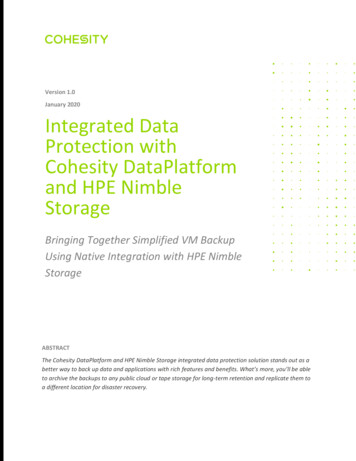
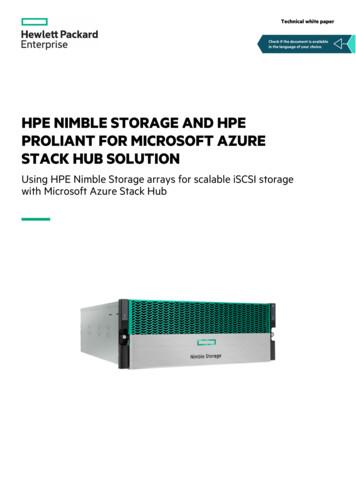
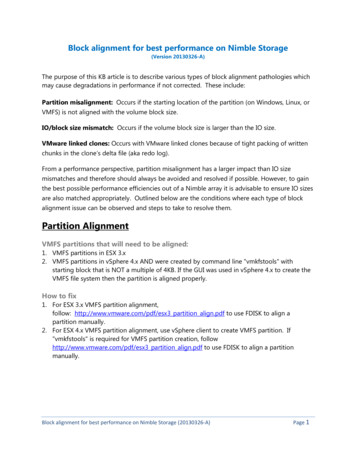
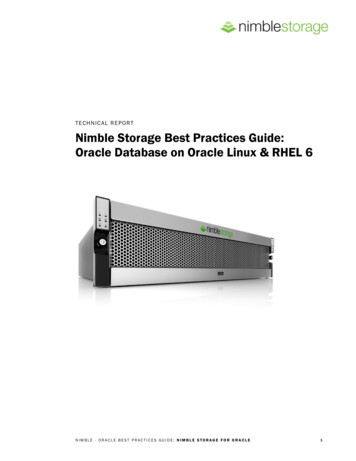
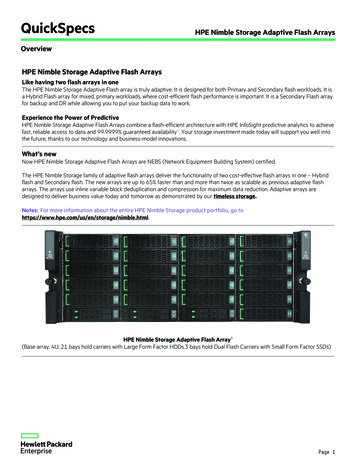
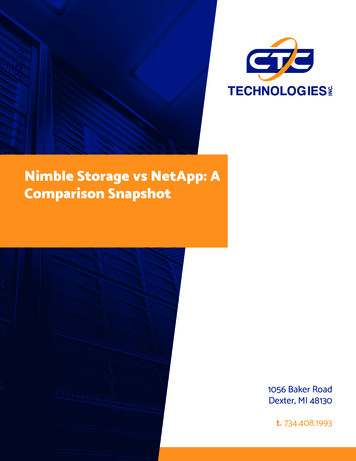
![Welcome [meec-edu ]](/img/34/system-source-nimble-storage-meec-webinar1.jpg)

